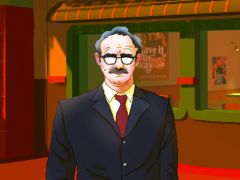Video Gamer is reader-supported. When you buy through links on our site, we may earn an affiliate commission. Prices subject to change. Learn more
An interesting (if not particularly engaging) period adventure – or walking simulator, if we’re going by Steam tags – Californium’s Philip K. Dick-influenced style glosses over the fact there’s little substance here. Not just in terms of mechanics, of which there are few, repeated, but also in that, for a game with a lot of talking, it quickly runs out of things to say, particularly if you’re not a fan of Dick’s work.
As former writer – and now a junkie masquerading as a writer – Elvin Green you’ll meander around a small section of a hyper-stylised Californian street, which is bisected by a road. (This road is your first sign that all is not as it seems, mainly because unlike real Californian roads it doesn’t take four days to cross.) Given Green’s high intellect, massive imagination, and colossal drug problem, it’s not long before things start disintegrating.
The core gameplay element – beyond walking, running, and occasionally falling out of the game world – sees you attempting to find runes hidden in the environment. Most of these puzzles are perspective-based, requiring the player to position themselves in certain places to reveal or align the runes. Clicking on them exposes portals to two other dimensions: the setting of each is the same street (or a facsimile of it), and each has a distinct style, from the deep orange of California ’67, to a counterfactual 50s rendered in cool blues, and finally onto the muted pinks of a far future.
Revealing these portals moves the environmental storytelling along, but it’s in your meetings with people on the street and in stores, offices, and government buildings where you’ll find out just what sort of a bind Green is really in. His role changes depending on the time period, but certain details remain: mainly that his family has left him, in one capacity or another.
There are no dialogue options, nor even simple responses, and the characters – which appear as flat sprites and look like cardboard cut outs – are both figuratively and literally two dimensional. There are hippies and blue-collar workers, hawkish G-men and exasperated magazine editors, and while most add to Californium’s hazy sense of simulation and otherworldliness, some of the (obvious) stereotypes are a bit too on the nose: a flamboyant future synth and a cowardly immigrant stand out amongst the rest of the ciphers used to tell the story, mainly for the wrong reasons.
Vietnam, Nixon, communism, drug addiction, racism and jingoism are all mentioned or alluded to but rarely probed, which works up to a point: Californium works best when the player feels dazed and confused by it all, little snippets of Green’s life – and the lives around him – tuning in before dropping out. The problem is that the subsequent worlds just aren’t as interesting as the first: the second feels like an unused prototype for Bioshock Infinite, and the third – a Mars colony – is dull. Playing as a disenfranchised writer in the turmoil of 60s Cali is interesting, particularly for games; playing as a martian overlord isn’t. Californium’s mechanics never changing or evolving is fine, if the underlying story is good. It’s not, particularly, no matter how interesting the whole affair may be.
There are also other problems which threaten to have players quitting before they’ve seen the credits. Finding the runes themselves can be incredibly tedious, given the that some are miniscule, well hidden, and only generally show when you’re close to them. It’s irritating, if not fatal, but far more concerning is how buggy the game is currently. It’s not uncommon to get stuck in or on scenery, or fall through it all together, forcing a restart. One (very) late game incident saw me pulled into and through a wall before taking a long fall back to the start of the level, which I now could not complete due to another collision error. Restarting is the only way to remedy many of these problems, which means losing progress. It also means that you’ll likely have to redo the chapter openings, which require the player to type out passages onto a typewriter or computer. A cute touch, given Green’s profession, but not one you’ll be keen to repeat.
There’s much to admire about Californium, and there’s no doubting its focus on the intersection between fantasy and reality gives it a style and atmosphere that pulls the player in. Once there, however, it sadly can’t build on what is an impressive opening, and an obvious love of the renowned author who inspired it.
